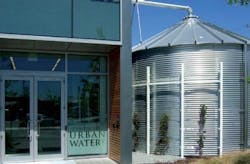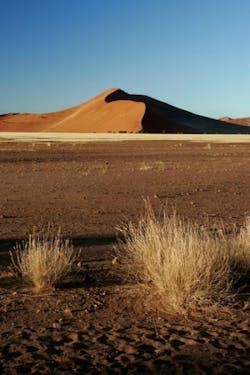Recharging India's Aquifers
Increased urbanisation across India has led to a severe depletion of aquifers near large cities. Huw Kidwell looks at recent World Bank recommendations and addresses the political hot potato of groundwater control legislation.
World water resources are becoming more difficult to manage and maintain. The constant pressure of increased irrigation needs for agriculture and industry had led to a massive problem with groundwater in India, according to recent report from the World Bank.
Entitled Deep Wells and Prudence: Towards Pragmatic Action for Addressing Groundwater Overexploitation in India, the report details the problems with increased exploitation of Indian groundwater across the country. It details why the problems are arising and makes suggestions as to what measures can be taken to preserve groundwater and even remediate and recharge these resources.
Some of the measures have potential for success and others will depend to a large extent on the Indian authorities and water users understanding the gravity of their situation and taking affirmative and definite action. Increased urbanisation coupled with inadequate provision of water supplies for the population have contributed to the depletion of aquifers near large cities. The encouragement of irrigation with subsidised power in agricultural areas has also contributed to the problem in rural settings.
Currently groundwater supports about 60% of irrigated agriculture and more than 80% of rural and urban water supplies. Certainly the development of cities and paved areas means that there is more run off during the monsoon season and as such less water soaks into the ground to recharge aquifers.
The problem is a complex one and there is no silver bullet solution. All are agreed that the first steps are realisation, education and understanding. In this way governments can use development assistance to improve water harvesting and recharge systems and relieve the strain on aquifers before they run dry and water becomes even more precious.
NASA scientists have already warned that the disappearing groundwater in northern India, particularly in the agriculture rich regions of Punjab, Haryana and Rajasthan that has been monitored using the twin satellites of GRACE (Gravity Recovery and Climate Change Experiment), is due to irrigated fields of wheat, rice and barley.
Even though the rainfall trend has not reduced in recent years the groundwater levels are still falling and these regions are facing collapse of agricultural output and a shortage of drinking water. Using satellite data the National Geophysical Research Institute in Hyderabad has calculated that northern India is taking 54 trillion litres of water out of the ground every year.
In the World Bank report the region of Andhra Pradesh is cited as an excellent example of where farmers have been educated in the ways to make groundwater use sustainable through the Andhra Pradesh Farmer–Managed Groundwater Systems (APFAMGS) Project. In some of the villages in this region farmers have reduced their groundwater use voluntarily and in doing so have still been able to irrigate crops and obtain drinking water.
The report has also looked into the factors driving groundwater usage and indicates that this may be because groundwater offers the "ultimate in modern convenience" for irrigation by providing control over quantity and timing of supply, which leads to higher productivity. Indeed, according to the data in the report, crop productivity of groundwater irrigated farms is twice that of the surface–water irrigated ones. In addition public use of groundwater is a response to poor service and delivery from urban water systems. Groundwater should not be used as a quick fix for the inadequacies of public water systems.
So what are the main problems with regulating groundwater usage across India?
Stephen Parsons, a project manager for Mott MacDonald in India, believes that India is such a large country that it is extremely difficult to police groundwater systems. With the encouragement of subsidised electrical power for farmers to power their pumps there has been a large increase in recent years in bore holes and wells to supply irrigation systems, he says.
The project manager provides technical assistance to the Ministry of Water Resources in Delhi under a World Bank funded project. He says that making changes now (such as cutting the electricity subsidy to make groundwater irrigation too expensive for the farmer), to preserve the disappearing groundwater table, is going to be unpopular.
The World Bank report has suggested that pricing measures for groundwater use, including volumetric charges, taxes and user fees, may be used to act as incentives to conservation and more efficient allocation of water resources, assuming that these measures also address the concerns of equity and affordability for the poor. However, pricing measures will be unpopular and extremely difficult to administer and police because of the land areas involved.
Groundwater control legislation is a political 'hot potato' in India; an example of this are laws currently being introduced in Karnataka where the process of getting the legislation through is faltering due to lack of popular support. So what is the way forward with groundwater control?
It is a difficult problem but the solution should be to promote better management of groundwater at a community level and encourage villages to be more proactive. To achieve this there has to be a big push forward in educating people on the problems with excessive groundwater use and to this end there are a lot of non–governmental organisations (NGO) working at the village level.
In addition to this there could be a move toward growing different crops that require less irrigation, increased rainwater harvesting, checking dams on local water courses and the development of more systems to promote recharge of groundwater resources during monsoon season rains. Currently a lot of monsoon rain is lost in runoff to the sea and if this could be encouraged to seep into the ground the aquifers would benefit.
On a different tack the last decade has seen a major increase in the development of IT and IT services in India, which is beginning to pull people from the land into higher paying employment in the city. This demographic change could well lead to a reduction in agriculture in rural regions and hence lower incidence of irrigation using groundwater. Ultimately, a decision has to be made to cultivate only the land areas where irrigation water is readily available or not needed at all. Mott MacDonald's Parsons cited a recent case where the groundwater problem is taking a higher priority. Recently, in Verna, companies in the Verna Industrial Estate have been drawing more than their fair share of water from the groundwater table via what is considered an excessive number of bore.
The local authority has invoked the Ground Water Regulation act of 2002 to cap all bore wells and require companies to seek permission to draw additional water beyond the requirement they have logged. The problem was first flagged up by local villagers.
They complained that in villages adjacent to the industrial estate the springs fed by the Verna water table were drying up or had dried up (these were providing the necessary water for several hundred villagers to carry on their day to day activities). It has been recommended by the local authority that all companies in the Verna Industrial Estate agree to carry out rainwater harvesting to assuage some of their requirements.
Of course all this is happening in an urban area where policing water use can be carried out by metering and extensive visits by officials. In rural areas the land areas to be covered are exponentially bigger and so policing is a much more difficult problem for the authorities. Although irrigated areas could be detected by satellite photographs and remote sensing, there are still enormous problems to be faced and therefore education followed by voluntary schemes are the best option.
Certainly the World Bank report has attempted to quantify the problem of over exploitation of groundwater resources and to provide a wide range of possible remedial actions. However, challenges remain. It is difficult to explain to farmers that a resource they have come to rely on to irrigate crops will now come at a premium price or will be closely controlled.
The path of least resistance would be to say that once the groundwater is gone, then it is gone and alternatives need to be found. This must not be allowed to happen if one of India's most precious resources – groundwater – is to be preserved. The most powerful weapon in the defence of India's groundwater has to be freedom of information, the education of farmers in rural areas and the encouragement of community projects to harvest rainwater and recharge aquifers. With the improvement of education groundwater may have a chance.
More Water & WasteWater International Current Issue Articles
More Water & WasteWater International Archives Issue Articles


